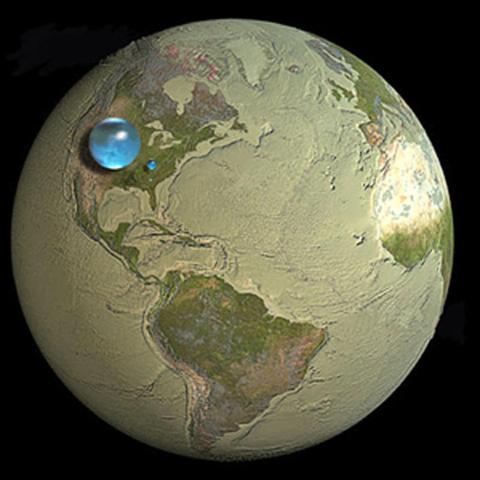Thailand under Water 3: A Drop in the Ocean
Thailand under Water 3: A Drop in the Ocean
What about those talks about icecaps, glaciers and mountaintop snow melting?
Really! Let's have some numbers? Let's look at this infographic:
< >
>
from http://water.usgs.gov/edu/earthhowmuch.html
... The volume of the largest sphere, representing all water on, in, and above the Earth, would be about 1,386,000,000 cubic kilometers (km3), and be about 1,385 kilometers in diameter.
The smaller sphere over Kentucky represents Earth's liquid fresh water in groundwater, swamp water, rivers, and lakes. The volume of this sphere would be about 10,633,450 km3 and form a sphere about 272.8 kilometers in diameter. Yes, all of this water is fresh water, which we all need every day, but much of it is deep in the ground, unavailable to humans.
Do you notice that "tiny" bubble over Atlanta, Georgia? That one represents fresh water in all the lakes and rivers on the planet, and most of the water people and life of earth need every day comes from these surface-water sources. The volume of this sphere is about 93,113 km3. The diameter of this sphere is about 56.2 kilometers. Yes, Lake Michigan looks way bigger than this sphere, but you have to try to imagine a bubble almost 56 km high—whereas the average depth of Lake Michigan is less than 91 meters....
A summary of water:
Oceans 96.54% of all 1.4 billion km3 of water in this world;
[Ice caps, glaciers, permanent snow 1.74% or 24 million km3]
Ground waters 1.09% or 23.4 million km3
Others in lakes, rivers, clouds, animals, etc. 0.63% 135 millions km3
<NB> * 1 m3 = 1,000 litres
** 1 km3 = 1,000,000,000,000 = 1 million megalitres
*** http://www.bhumiboldam.egat.com/ says: เขื่อนภูมิพล รองรับน้ำได้สูงสุด ๑๓,๔๖๒ ล้านลูกบาศก์เมตร (megalitres)
What about icebergs?
Icebergs are like ice cubes in our iced tea cup, when they melt, our tea level does not rise. (Go on test this out.) But ice, snow and glaciers on land when they melt, more water is added to oceans. Right? (Go on put a paddle on top of a glass of water and put an ice cube on the paddle and wait and see.)
How much the sea water level will rise if all 24 million km3 of ice caps, glaciers, permanent snow (1.74%) is added to1.4 billion km3 cubic kilometers of water in this world? (Try adding 2 drops of water into a glass of 100 drops.)
And looking back at the topological map (in <Thailand under Water http://www.gotoknow.org/posts/575607>) we can see that water stays in bowl-like land features -- wider at the top, narrow at the bottom -- . (Get a bowl, a ruler and 2 cups of water. Pour 1 cup of water into the bowl, measure the depth and write it down like any good researcher. Then add another cup of water into the bowl, measure the depth and write it down again. How much does the water level in the bowl rise up?) So more volume of water is needed to raise the level up another notch.
Then what is this talk about rising temperature, melting ice caps at both poles and rising sea water about?
...I am sure we are curious and want to get to the bottom of this. But can you wait?
<NB> Some numbers for play with while we wait:
http://www.simetric.co.uk/si_water.htm :
The Expansion of Water at Various Temperatures
The following table shows the volume that 1 gram of water occupies as temperature varies. Data corrected for buoyancy and for the thermal expansion of the container.
Temperature (°C) Volume (mL)
17.0 1.0022
18.0 1.0024
19.0 1.0026
20.0 1.0028
21.0 1.0030
22.0 1.0033
23.0 1.0035
24.0 1.0037
25.0 1.0040
26.0 1.0043
The thermal coefficient of expansion of water is 0.000214 per 1° Celsius at 20° Celsius.
http://www.engineeringtoolbox.com/volumetric-tempe...
Example - Cubic Expansion of Water
Volumetric Temperature Coefficients - β - water : 0.000214 (1/oC)
100 liters of water is heated from 20oC to 80oC. The volumetric expansion of the water can be calculated by using equation 2: dV = (100 liters) (0.000214 1/ oC) ((80 oC) - (20 oC)) = 1.28 litre or 1.28 %
ความเห็น (0)
ไม่มีความเห็น